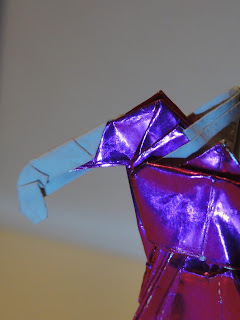There is very little derivation from 126A and 126B, but look how shiny it is. The foil holds its shape really well and it's a bit easier to manipulate this one into standing. It also allowed me to get the folds in the upper legs worked out properly. Best of all, the paper easily held up to the strain that tore through yesterday's attempt.
I'm beginning to suspect this shoulder spike problem is something that's going to come up often.
The arms also came out a bit better than my last attempt.
The secondary color on 126A runs the length of each leg, half the torso, the forearms, and the shoulder spikes.
The tradeoff for the rigidity is that the model is wafer thin. It's nice that I don't have to use any glue to hold it together, but I miss the heft of the other models.
Here's a side-by-side comparison to illustrate the difference in the two models' patterns and size. Again, I miss the bulk of the larger model, but I'd give it up if the tradeoff is accuracy and stability.






No comments:
Post a Comment